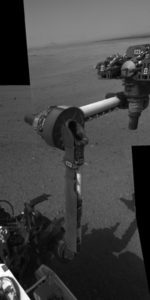
If you are a traditionalist, you might choose a gift with a coral theme for your 35th wedding anniversary; or, if you prefer a more modern approach, perhaps something of jade would serve as an alternative. Neither was forthcoming in recent weeks as humanity’s most distant emissaries continue relentlessly pushing the boundaries of our knowledge and draw inexorably closer to the very edge of our Solar System as each day passes. Voyagers 1 and 2 – or 2 and 1, to place them in their correct launch order – rode Titan 3E-Centaur boosters into space from Cape Canaveral Air Force Station in the late summer of 1977 to exploit an unusual alignment of the outer planets. Both would visit Jupiter and Saturn and, if conditions proved satisfactory, Voyager 2 was expected to also pass close to Uranus and Neptune. No one could have foreseen that both missions would still be returning valid scientific data almost four decades later.
Even before they left Earth, the missions seemed jinxed. This is particularly true of the hours before Voyager 2’s launch on 20 August 1977. This spacecraft was sent aloft ahead of its twin, Voyager 1, because its trajectory had been designed to preserve an option to visit Uranus and Neptune…but shortly before its date with destiny, sitting atop its Titan rocket on the pad, it suffered a double computer failure. Another such failure followed as it ascended into the clear Florida sky. Fortunately, the Titan’s Centaur upper stage compensated for the computer problems and a little more than an hour into the mission Voyager 2 left Earth’s gravitational well, forever, and was set on course for a rendezvous with Jupiter. All seemed back on the straight and narrow; until, that is, Voyager lifted off on 5 September. Shortly after reaching space, its scan platform jammed. In the weeks that followed, one of Voyager 2’s hydrazine thrusters ended up pointing in the wrong direction and sprayed propellant at the spacecraft itself, demanding the expenditure of more propellant to keep it on course.
One of the most serious problems to face Voyager 2 came in April 1978, when controllers lost command capability with its main radio receiver, effectively leaving the spacecraft partially deaf. Eventually, contact was re-established, but during the switching process an electrical short blew both fuses in the main receiver. It was effectively dead. The consequences had the potential to ruin the mission. “Thrusters fired at inappropriate times, data modes shifted, instrument filter and analyser wheels became stuck and various computer control systems occasionally overrode ground commands,” remembered David Morrison, a member of the Voyager 2 imaging team. “The computers on board displayed certain traits that seemed almost humanly perverse, even psychotic!”

With these problems in mind, it is quite remarkable that both Voyagers not only accomplished their primary missions in spectacular style, but eclipsed them massively in terms of their scientific yield. Flying a faster trajectory, Voyager 1 passed the distance of its twin in December 1977 and was first to reach Jupiter in March 1979 and Saturn in November 1980. Although both planets had been visited previously by Pioneer 10 and 11, the Voyagers returned imagery and data which dwarfed all previous understanding: revealing tantalising clues of volcanism on Io, photographing an icy surface on Europa, resolving the intricate rings of Saturn and peering into Titan’s opaque orange atmosphere. For Voyager 1, the departure from Saturn was its final planetary encounter, but Voyager 2’s trajectory had been designed to permit a rendezvous with Uranus in January 1986 and Neptune in August 1989. These visits provided human eyes with their first glimpse of never-before-seen planets for the last time in the 20th century, revealing the misleadingly bland face of Uranus and the unexpected vitality of the Neptunian atmosphere, with its Great Dark Spot and cirrus-like scooter clouds.
With increasing frequency in recent years, news reports emerge that the Voyagers are approaching the edge of our Solar System. In June of this year, NASA announced that Voyager 1 – presently around 11 billion miles from the Sun – had recorded a marked increase in the detection of charged particles from interstellar space. This has led to renewed optimism that it is closing in on the outermost edge of the Sun’s sphere of direct influence, known as the ‘heliosphere’. Present estimates are that the craft will enter the interstellar medium anytime between now and 2015. Limited power reserves from the depleted Radioisotope Thermoelectric Generators mean that the systems of both Voyagers are in the process of being shut down and in the next few years there will be insufficient electricity to run a single scientific instrument.
Let us hope that the first data from beyond our Solar System is received before the Voyagers fall silent forever.
Ben Evans is the author of ‘NASA’s Voyager Missions: Exploring the Outer Solar System and Beyond’, published by Springer-Praxis





I never knew until now, how much nail-bitting the launch of the Voyagers were, and how many problems they faced! It’s almost inconceivable to think that the Voyagers were a few seconds close of being trapped in Earth orbit due to launch booster problems! They always seemed to me as calm, no-bad-events missions.
I still remember lovingly and tenderly the days in August of 1989, as Voyager 2 passed by Neptune and the planet’s magnificent blue disk was unveiled before my eyes! As a 10-year old space enthusiast then, I would devour with never-ending hunger all the spectacular full-frame photograps of a serene blue disk swirling peacfully. To my child eyes, it was one of the most wondrous of sites! And I would create countless collages and hang them on my bedroom wall and stich all the newspapers articles an photos together in my ‘Space Notebook’ and write captions under each photo, crating my own ‘Space Exhibition’ : ) How I wish I had these hand-made notebooks still!
Anyway, thanks for the memories Ben!